Editor's note: Todd Remington is president of The Fairfax Research Group, Ontario, California.
Every day millions of Americans listen to a stranger trying to sell them something by telephone. Does the staggering growth in the volume of telemarketing sales calls present problems for professional survey research organizations and their clients?
Concerned with rising refusal rates and harboring a theory about the contributions of telemarketing to these rising rates, Western Wats Center and The Fairfax Research Group decided to explore the theory. We developed a questionnaire designed to begin to assess the impact of telemarketing on respondent cooperation. Western Wats Center and Fairfax Research interviewed 1,000 adults age 18 and older living in the lower 48 states between January 31 and February 5, 1991. The interview lasted 15 minutes.
Irreconcilable differences: privacy and the telephone
Increases in unlisted telephone numbers corresponding with rises in refusal rates and the proliferation of telephone answering machines present research firms and clients alike with formidable methodological and financial obstacles. One response from an individual who refused to participate in this study illustrates these difficulties. When asked why they wouldn't participate in the study, this individual flatly stated: "Basically it's like phone harassment. We get so many of these calls that the best way to handle it is to just hang up." Said another of these respondents: "You're calling at 6:45 p.m. You had a day and you've dealt with society and then the phone rings and guess what - it's an intrusion." In short, Americans have a limited reservoir of goodwill to expend on intrusive and unsolicited telephone contacts of any kind: reasonable or unreasonable. Overuse of this reservoir will engender a drought in respondent cooperation with accompanying serious short-term and long-term ramifications for the research industry. Using either advances in technology or a good, old-fashioned "no," too many potential respondents will avoid participation in any form of telephone contact. We suspected that telemarketing flagrantly depletes this fragile reservoir.
Telephone contacts: surveys and sales
Fifty-eight percent (58%) of the respondents say they have previously participated in a telephone survey other than this one. Significantly more of them say they have previously received at least one telemarketing sales call. Seventy-three percent (73%) of the respondents say they have received at least one telemarketing sales call.
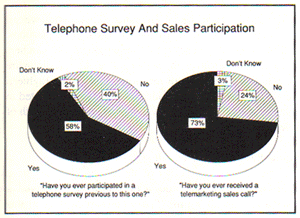
The findings suggest that telemarketers target individuals between 25 and 54 years of age. More respondents in these age groups say they have received a telemarketing call. Seventy-nine percent (79%) of the 25-to-34 year olds, 81% of the 35-to-44 year olds and 80% of the 45-to-54 year olds have received a telemarketing call.
Better educated Americans also claim to receive more telemarketing calls. Eighty-six percent (86%) of the respondents with a college degree and 92% of the respondents with a postgraduate degree say they have received a telemarketing sales call.
Income level also dictates telemarketing activity. Telemarketers clearly target the affluent. The more respondents earn the more the phone rings with some telemarketer's solicitation. Just 53% of the respondents who earn less than $10,000 a year say they have received a telemarketing call compared to 85% of the respondents who earn $35,000-to-$50,000 a year, 82% of the respondents who earn $50,000-to-$75,000 a year and 89% of the respondents who earn over $75,000 a year.
More respondents 35-to-44 years old (68%) and 45-to-54 years old (65%) say they have participated in a telephone survey. Home owners (63%) and respondents with a college degree (65%) or postgraduate degree (77%) also report higher participation rates in telephone surveys.
Survey participation increases with an increase in income. Just 35% of the respondents earning under $10,000 a year say they have participated in a telephone survey. By contrast, 68% of the respondents earning between $50,000 and $75,000 a year and 73% of the respondents earning over $75,000 a year say they have participated in a telephone survey.
More respondents living in the suburbs (64%) say they have participated in a telephone survey than their counterparts living in urban areas (57%) or rural areas (50%).
Respondents recall receiving an average of 26 sales calls in the past 12 months. By contrast, they recall participating in an average of less than two (1.68) telephone surveys during the same 12 month period.
The number of telemarketing calls received by respondents varies sharply by age, education and income. The findings suggest that telemarketers target older, better-educated, more affluent Americans. Telemarketers called 35-to-44 year old respondents an average of 30 times a year, while they called 45-to-54 year old respondents an average of 36 times a year. By comparison, 18-to-24 year old respondents say they received just 18 calls a year. 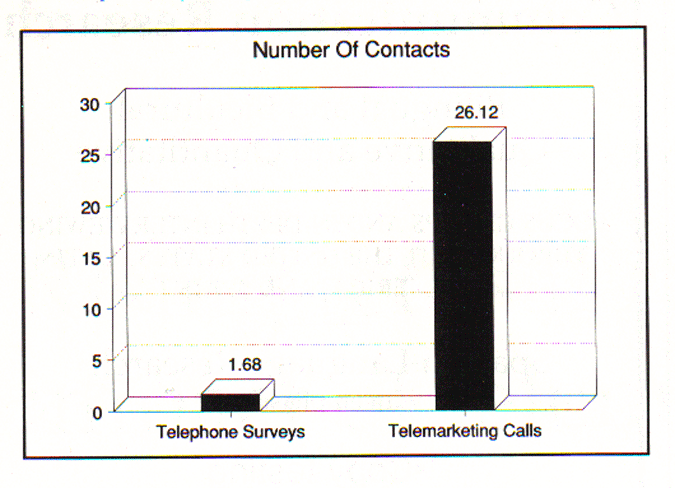 Respondents with a college degree say they received 32 calls while respondents with a postgraduate degree say they received an average of 47 sales calls a year.
Respondents with a college degree say they received 32 calls while respondents with a postgraduate degree say they received an average of 47 sales calls a year.
The phone rings more frequently in households with yearly incomes of $50,000 or more: $50,000 to $75,000 (42 calls), over $75,000 (40 calls).
Homeowners (31 calls), suburban residents (33 calls) and respondents living in the Western United States (37 calls) are also favorite targets of telemarketers. By contrast, Midwesterners average a comparatively few 19 sales calls a year.
Interestingly, for those respondents who say they have participated in a telephone survey in the last 12 months, the frequency of participation evidences little variance between demographic groupings. Generally speaking, most telephone survey respondents, regardless of age, income or education level, participated in an average of two telephone surveys.
Survey length
Based on the respondents' recollections of the length of the most recent telephone survey they participated in, prudent researchers are evidently limiting the length of their telephone surveys. The respondents in the study who have participated in a telephone survey estimate that the last survey they participated in lasted approximately five and a half minutes (5.53). These respondents volunteer experiences with surveys varying in length from brief one minute surveys to protracted fifty minutes ones.
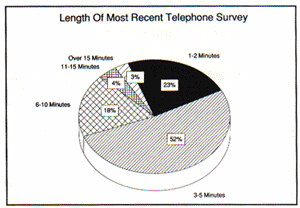
We should note that four years of validation studies suggest that the majority of survey participants typically underestimate by half the actual survey length. In those studies, we call back a sample of the respondents and, among other questions, ask them their estimate of the survey length. Researchers must remain sensitive to the length of the questionnaire despite the client's desire for more information. Eighteen percent (18%) of the respondents who have participated in telephone surveys voluntarily complain about the length of telephone surveys.
Immediacy of last sales call
Forty-one percent (41%) of those who say they have received at least one sales call claim they received a telemarketing call within 10 days of participating in this survey. Seventy-two (72%) percent of them say they have received a sales call within 30 days of this survey.
Forty-four percent (44%) of the homeowners, 52% of the college graduates, 48% of the postgraduates, 48% of those earning $50,000-to-$75,000 a year and 55% of those earning over $75,000 a year claim they have received a telemarketing call within 10 days of participating in this survey.
General perceptions of surveys and sales calls
Respondents harbor remarkably unfavorable impressions of telemarketing. Asked to rate telemarketing or telephone sales calls on a one-to-seven scale where one means they have an extremely unfavorable impression of telemarketing and a seven means they have an extremely favorable impression, respondents rate it an average of just 1.94. Telephone surveys fare considerably better in the ratings. Respondents rate telephone surveys significantly higher than they rate telemarketing. They rate telephone surveys an average of 4.94 on a one-to-seven scale.
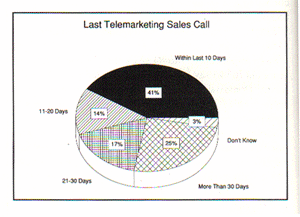
Respondents who have experienced both a sales call and a survey in the last 12 months (34% of the respondents received a sales call and participated in a telephone survey in the past 12 months) rate telemarketing an average of 1.82 and telephone surveys an average of 5.09. Respondents who know the difference between telephone surveys and telemarketing rate telemarketing significantly lower than do respondents who don't know the difference between the two. Respondents who say the two are different rate telemarketing an average of 1.81 on a one to seven scale, while respondents who erroneously believe they are the same rate telemarketing an average of 2.14 on a one to seven scale. Perceptions of telemarketing tend to worsen as the age, education and income of the respondent increases. This is not an entirely surprising finding given that telemarketers tend to inundate these respondents with their sales and solicitation calls. Respondents 18-to-24 years old rate telemarketing an average of 2.33 compared to respondents over 55 years of age who rate it an average of 1.78.
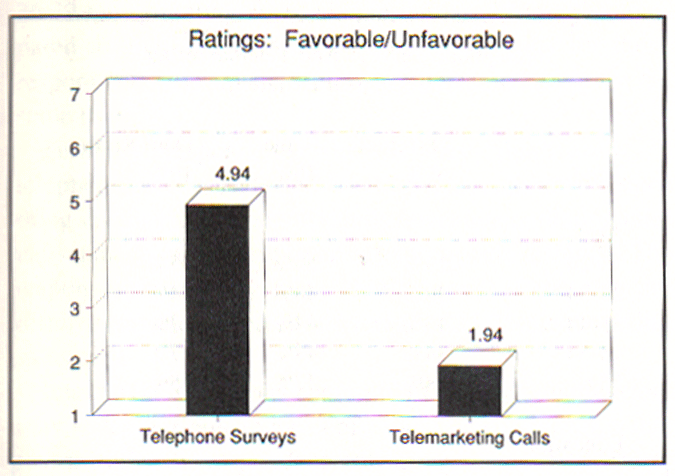
Respondents with a high school degree or less formal education rate telemarketing an average of 2.01 compared to respondents with a postgraduate degree who rate it an average of 1.62.
And respondents earning $10,000-to-$20,000 annually rate telemarketing an average of 2.21 compared to respondents earning $50,000-to-$75,000 annually who rate telemarketing an average of 1.69.
Evaluations: surveys and sales
Respondents who say they have actually received a sales call or participated in a survey offer a more informed evaluation of the two industries. Specifically, those respondents who say they have received a telemarketing sales call generally consider their most recent sales call an unpleasant experience. They collectively rated the experience an average of 2.40 on a one-to-seven scale where a one represented an extremely unpleasant experience and a response of seven depicted an extremely pleasant experience.
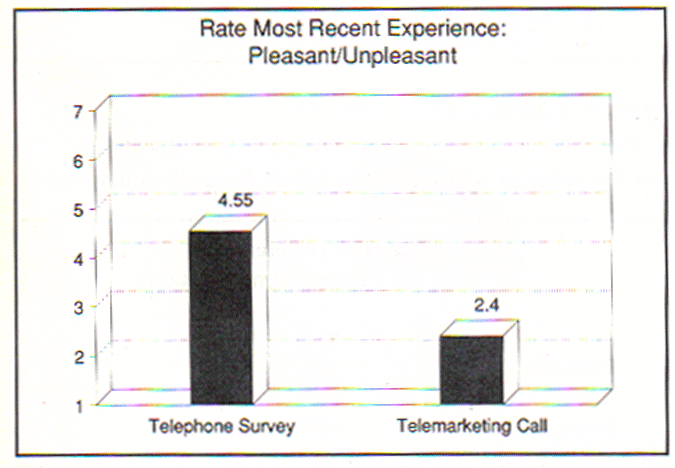
In comparison, respondents consider their most recent telephone survey a more pleasant experience. They rate their most recent telephone survey experience an average of 4.55 on the same one-to-seven scale. Respondents who say they have received both a sales call and completed a telephone survey in the past 12 months rate their survey experience an average of 4.59 and their telemarketing experience an average of 2.22. When asked what they liked about both the sales call and the telephone survey, the respondents criticize telemarketing more frequently than they do telephone surveys. Among respondents who have participated in a previous survey, 20% of them said they didn't like anything about their most recent telephone survey experience. By comparison, 62% of the respondents who have received a telemarketing sales call say they didn't like anything about their most recent sales call experience.
The boiling point
On a one-to-seven scale where a seven means they are extremely bothered by the number of telemarketing calls and a one means they are not bothered at all, respondents put their aggravation level at a mean of 3.90.
A serious problem: telemarketing obfuscation
When asked if there is any difference between telephone survey research and telemarketing, or whether they are basically the same thing, two-thirds of the respondents (65%) believe that surveys and telemarketing are the same thing or they "don't know" if they are different.
The ability to differentiate between surveys and sales calls differs by age, education and income.
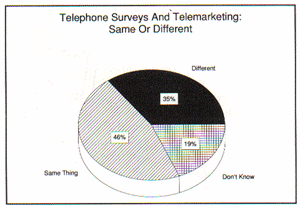
In the case of telephone surveys and telemarketing sales calls, experience appears to be a good teacher. More respondents who feel surveys are different from telemarketing sales calls claim to have actually participated in a survey (68% of them) than have respondents who do not differentiate between surveys and telemarketing sales calls. Approximately one half of the respondents who believe surveys are the same thing as telemarketing (56%) or "don't know" if they are the same thing as telemarketing (50%) say they have participated in a telephone survey previous to this study. More of the respondents who don't differentiate between surveys and telemarketing say they have never participated in a telephone survey. 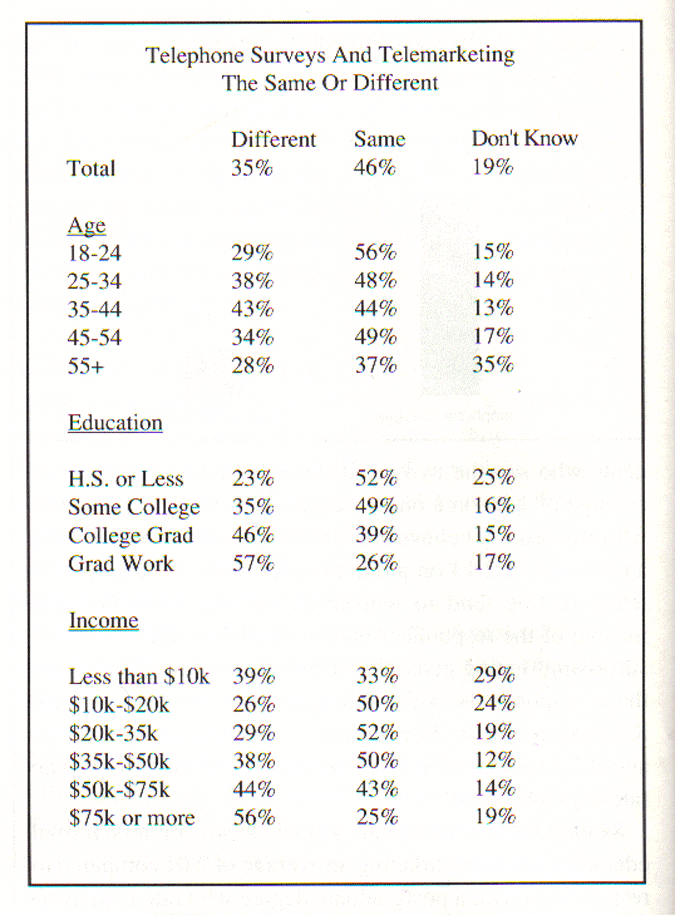
Similarly, though to a lesser extent, respondents who can differentiate between surveys and sales calls say they have received a telemarketing sales call. 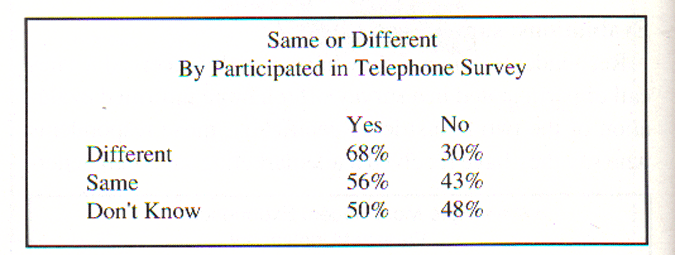
Those respondents who accurately relate that surveys are not the same as telemarketing report a significantly higher incidence of telemarketing contacts. Respondents who say surveys are different from telemarketing recall an average of 36.72 telemarketing sales calls in the last 12 months compared to an average recall of 19.51 sales calls for those respondents who say that surveys and telemarketing are the same thing. 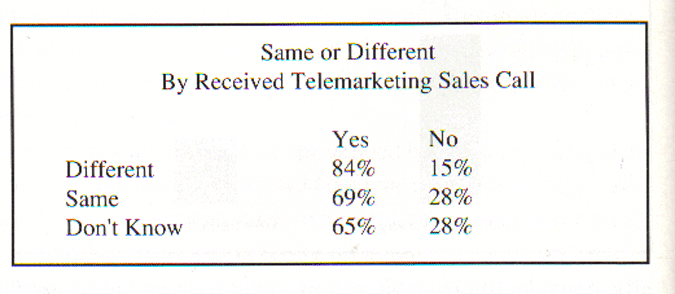
Similarly, respondents who say they "don't know" if telephone surveys and telemarketing sales calls are the same thing say they receive significantly fewer telemarketing sales calls than do respondents who say surveys are different. The respondents who say they "don't know" if the two are different say they received an average of 25.25 telemarketing sales calls.
Intentional deceptions committed by some telemarketers may well contribute to the confusion. The good news is that two-thirds of the respondents (68%) say they were properly informed of the subject matter during the introduction of their most recent telemarketing call. The bad news is that one-quarter of them (26%) say they were not properly informed of the subject matter of the telemarketing call.
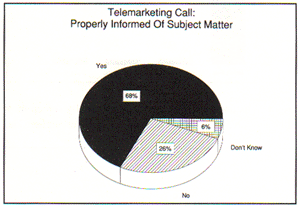
Far too many respondents have participated in a sales pitch disguised as a telephone survey (selling under the guise of research or "lugging"). Approximately one-quarter (24%) of the respondents have experienced this disguised sales pitch. The magnitude of the problem presents troubling questions for the integrity of telemarketers and challenges the research industry.
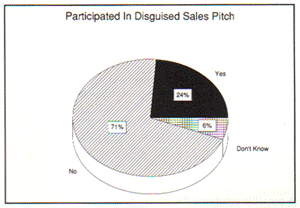
Interestingly, nine percent (9%) of the respondents who have refused to participate in previous surveys, when asked why they refused, say they feared the call was actually a disguised sales pitch. Furthermore, when asked why companies conduct telephone surveys, most of the respondents correctly volunteered the purposes for this type of research. Unfortunately, seven percent (7%) of them erroneously believe that companies conduct surveys in order to sell something.
Telephone survey refusals
Twenty-one percent (21%) of the respondents who participated in this study say they have refused to participate in a previous survey. And typically they have passed up more than one opportunity to participate in a survey. As a group, they average three refusals.
Telephone survey refusal rates climb among the better educated and the more affluent. Twenty-seven percent (27%) of the respondents with a postgraduate degree say they refused to participate in a survey within the past 12 months. Similarly, 29% of the respondents with incomes of more than $75,000 a year say they refused to participate in a survey within the past 12 months.
Westerners also claim to refuse to participate in surveys more frequently than do respondents living in other regions of the country. Twenty-five percent (25%) of the Westerners, 21% of the Midwesterners, 19% of the North-easterners and 18% of the Southerners say they refused to participate in a telephone survey in the previous 12 months.

More of the respondents who say they refused to participate in a survey in the last 12 months have also received a telemarketing sales call.
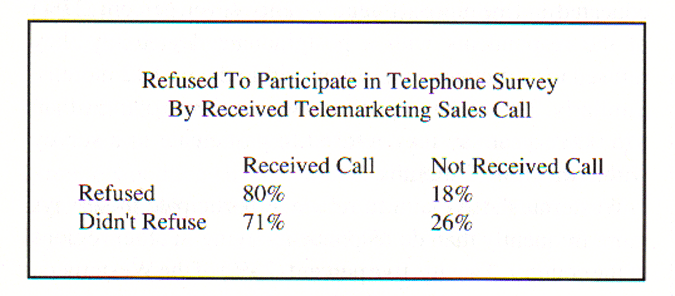
A second problem: telephone answering machines
Forty-five percent (45%) of the respondents say they have a telephone answering machine.
Answering machine ownership is higher among 25-to-34 year olds (53%) Republicans (50%), and individuals living in the West (52%). 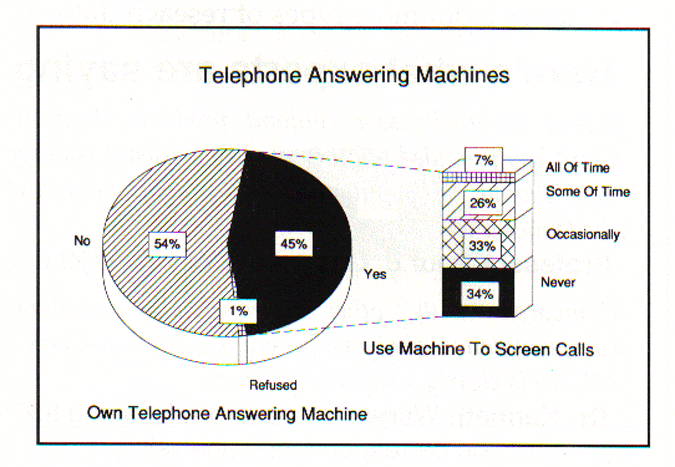
Answering machine ownership increases dramatically with increases in education and income. Sixty- one percent (61%) of the respondents with a college diploma and 64% of the respondents with a postgraduate degree own a telephone answering machine. Just 32% of the respondents with less than a high school degree own a telephone answering machine. Similarly, only 20% of the respondents earning under $10,000 a year own a telephone answering machine compared to 66% of those earning $75,000 or more annually.
Just 34% of the respondents in outlying rural areas say they own a telephone answering machine.
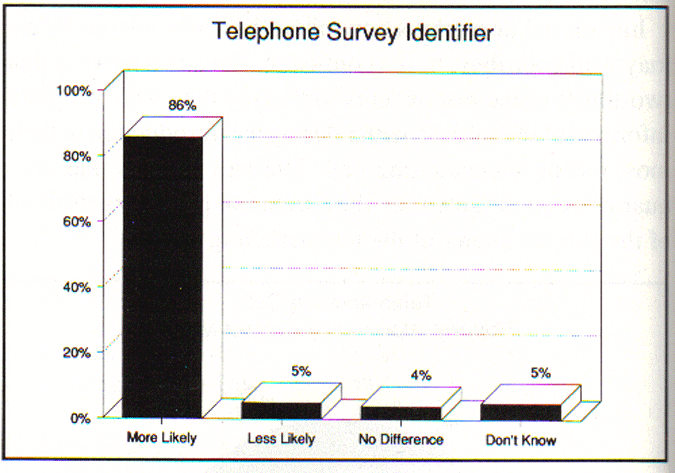
Few of the respondents who own telephone answering machines say they use them to screen their calls all of the time (7% of the respondents with machines). Still, a sizable 26% of the respondents say they do use the machine to screen their calls at least some of the time. Additionally, 33% of the respondents use their machines to occasionally screen their calls. This creates obvious challenges for the researcher. The more these people get assailed with unsolicited calls, the greater the temptation to use their answering machines to screen all their calls. 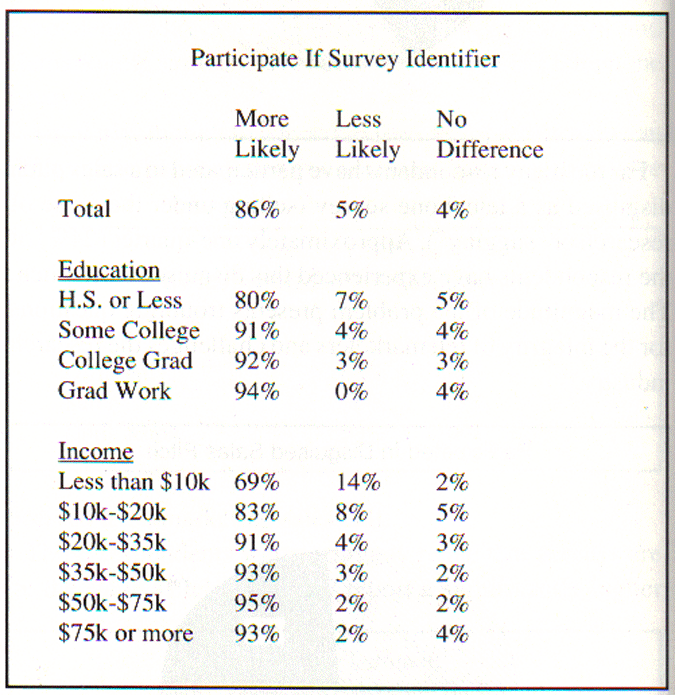
A possible solution: the survey identifier
The findings suggest that if respondents knew immediately (within the first 30 seconds) that the call was a legitimate telephone survey, they would be more likely to cooperate with the survey. A well-constructed, widely-known research identifier might improve response rates among respondents normally reluctant to participate in a survey. Eighty-six percent (86%) of all respondents claim they would be more likely to participate in a telephone survey if they learned within the first 30 seconds that the call was a legitimate survey.
Moreover, 80% of all respondents who have refused to participate in a survey in the past say they would be more likely to participate if they knew the call was to conduct a legitimate telephone survey, rather than to sell them something.
Time and timing
The findings strongly suggest that cooperation appears to be a function of schedules and timing. When asked to volunteer what they didn't like about a previous telephone survey experience 21% of the respondents mention inconvenience (timing), and 18% of them mention survey length (time). Affluent respondents reveal a special sensitivity to the time and timing issue. Respondents earning over $75,000 a year, in particular, complain about the interruption/inconvenience (29%) and length of the survey (27%).
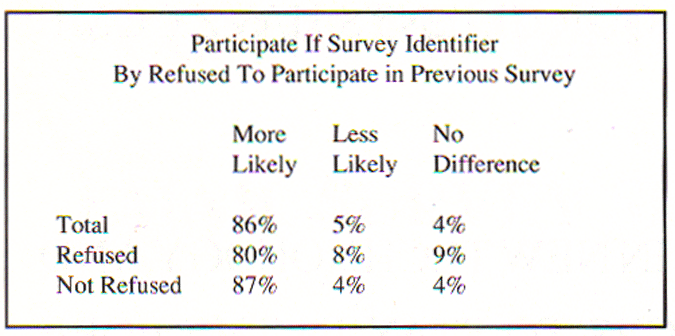
Respondents refused to participate in past surveys for the very same reasons: 32% said they "did not have time" to complete the interview and 22% of them mention "called-at an inconvenient time." Forty-five percent (45%) of the respondents with a college degree and 48% of the respondents earning over $75,000 a year refused to participate in a survey because they did not feel they had the time to participate.
Similarly, respondents dislike the interruption of a telemarketing sales call.
While their dislikes of surveys focus on the time and timing of the call, too many respondents experience pushy and rude telemarketing representatives. A small number also complain about the computer dialing used by telemarketers. Neither of these complaints surfaced concerning survey interviewers. Many respondents say they don't like sales calls because they just don't buy things over the phone.
Although not completely innocent of damaging respondent goodwill, research pales in comparison to some of the offenses perpetrated by the telemarketing industry. Abrasive tactics seem to strain the respondents willingness to cooperate with any unsolicited telephone calls, be they surveys or telemarketing. Additionally, the explosive growth in the volume of telemarketing sales calls depletes the scarce stock of time individuals are willing to allocate to telephone related contact. This logically depresses the individual's willingness to cooperate with a legitimate survey.
Serious questions
The survey raises serious questions about the damage telemarketing inflicts on the respondents' willingness to conduct telephone surveys. This finding suggests that the abuses of telemarketing along with the conflicting demands for telephone time threaten to seriously diminish the goodwill essential to the completion of valid survey research. 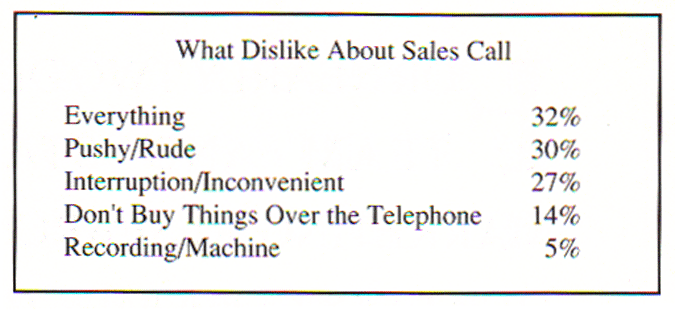
None of this excuses the survey research industry (and their clients). Far too many research organizations field surveys longer than the fifteen minutes recommended by many research industry leaders. The findings of this study strongly suggest that one experience with a protracted survey may convert a once willing respondent into a potential non-responder. Nevertheless, the ubiquitous presence of telemarketing does seem to contributing to the rising refusal rates.
